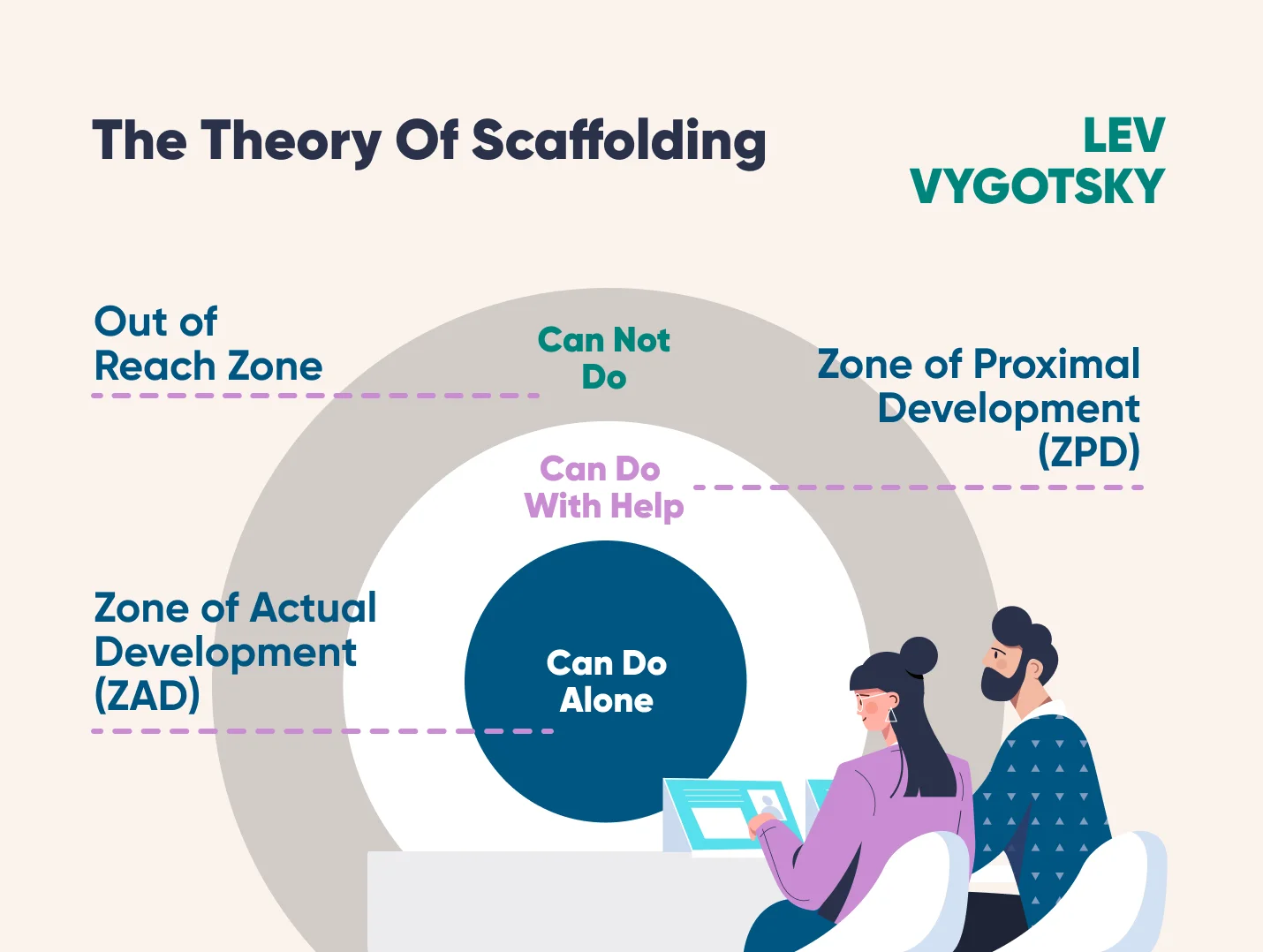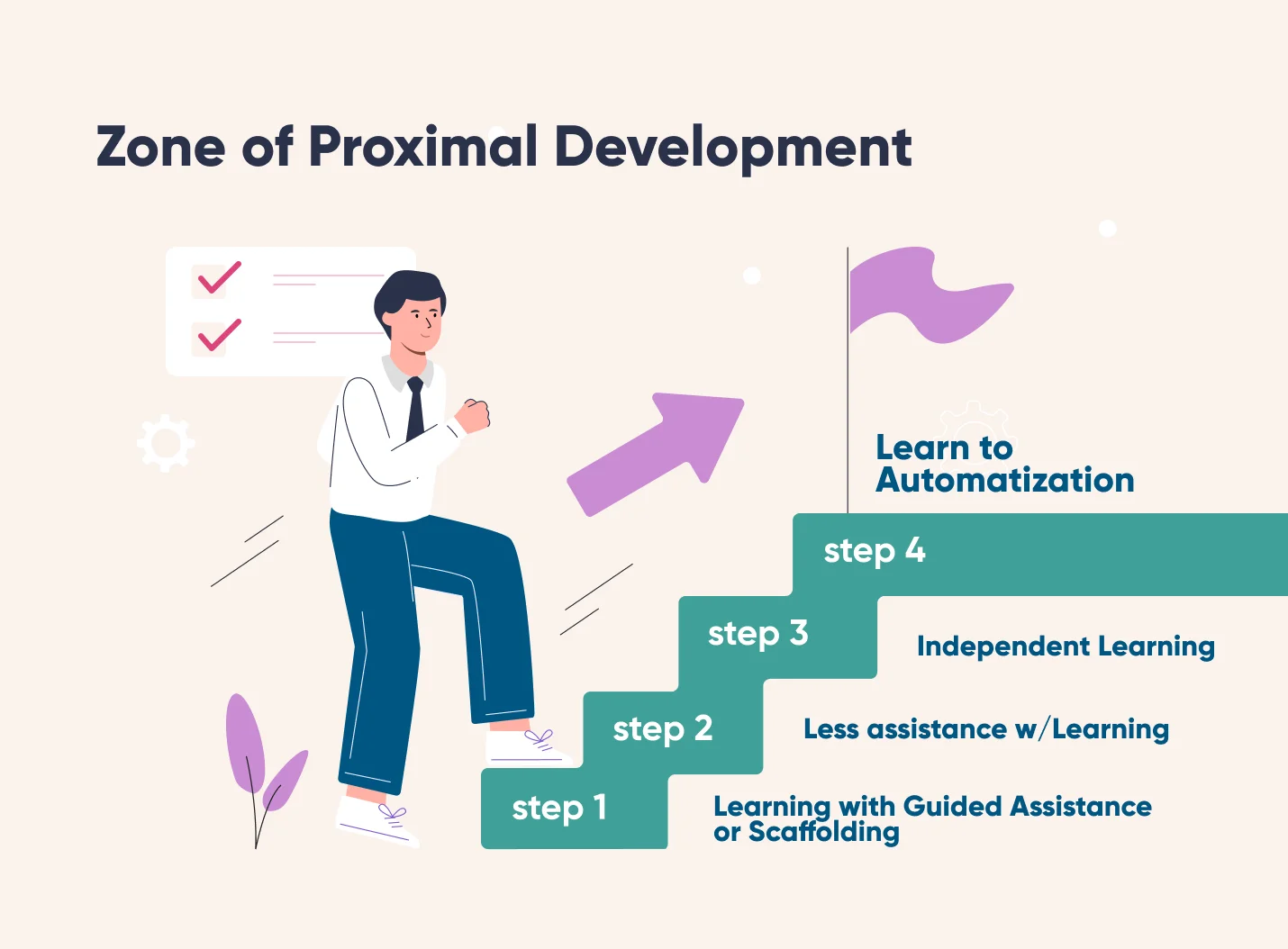The zone of proximal development (ZPD) is the range of skills that an individual can execute under the supervision of an expert but cannot yet perform on their own.
This learning theory, developed by psychologist Lev Vygotsky, can be witnessed in a classroom environment or anywhere else where an individual has the potential to gain new abilities. Vygotsky gained recognition for his sociocultural theory, which explains cognitive development as a result of social interactions that differ across cultures
In this post, we will go through this topic in depth, assessing its influence on children’s growth and learning.
Zone of Proximal Development: Definition
Also known as the zone of potential development, the method is frequently utilized in classrooms to assist students with skill development. The ZPD’s basic concept is that a more educated individual can boost students’ learning by leading them through a task somewhat beyond their competence level.
“The zone of proximal development defines functions that do not yet comply, but economies in the process of rapid development, which are aware of tomorrow, which is now still in their infancy; functions that can be called not the fruits of development, but the buds of development, the flowers of development, that is, a topic that is only ripening” – L. Vygotsky
The ZPD is determined by the substance of those tasks that the kid cannot yet perform on their own but can solve in cooperative activities with an adult, according to Vygotsky. What is initially available to a youngster under adult supervision becomes their personal property (skills, capacities). Its existence suggests that an adult is leading a child’s mental development. Development processes, according to Vygotsky, follow learning processes.
Properly structured learning builds on the child’s ZPD, where mental processes develop through collaboration with adults before becoming part of independent activities. It also incorporates the child’s existing system of scientific conceptions. The notion of the Zone of Proximal Development also helps us to describe development opportunities and prospects. Its definition is critical for identifying a child’s mental development.
A Student’s Potential Development
ZPD provides an understanding of the child’s internal state and potential development opportunities, allowing for a reasonable forecast and practical psychological and pedagogical recommendations about the optimal terms of education for both large groups of children and individual children. According to Vygotsky, only education that comes before development is beneficial; education should come before development and be its source. Then, it awakens and brings to life numerous more functions that are being developed. Training can be centered both on previously completed development cycles and on functions that have not yet developed on ZPD — the maximum training threshold.
Learning as a Social Process
According to L. S. Vygotsky, learning is a collective activity that occurs in collaboration between an adult and a kid in the position of “equals”. Developing the child’s features has its closest basis in ego collaboration with other individuals. L. S. Vygotsky also added that the social environment and the adults around the kid do not resist or reconstruct their nature but are recognized as an organically required condition for their human growth.
Lev Vygotsky thought that education and parenting significantly affect a child’s mental development. He believed that ZPD determines mental functions that are maturing. It connects to child psychology topics such as the emergence of higher cognitive processes, the link between learning and mental growth, and the key drivers of a child’s mental development.
A child cannot grow or thrive in isolation; socialization begins at birth, and younger children tend to be especially social.
The Theory Of Scaffolding
Vygotsky’s scaffolding began when other theorists used his zone of proximal development theory in the classroom. Vygotsky’s scaffolding is a teaching strategy that assists students in learning educational information by collaborating with an instructor or someone more knowledgeable about the subject.
According to the principle, students learn better when working with people with a more extensive range of expertise than those learning the material. Educators or peers break the content into smaller pieces, helping learners expand their understanding beyond what they could achieve alone
Guidelines for Scaffolding Instruction (Silver, 2011)
- Select assignments that correspond to the curriculum’s aims and the demands of the students.
- Allow students to design their own instructional goals based on their present zone of proximal development, which can boost their drive to achieve.
- To assist learners in creating a link between the content they’re learning and knowledge they already know, use a range of instructional tools such as asking questions, producing diagrams, and sharing relevant stories to guide them through a task.
- Encourage learners to need less instructional help as they get more familiar with new knowledge so they can finish the job independently with less instructional scaffolding.
- Educators use feedback to track student development.
- Create a warm, safe, and supportive learning atmosphere that encourages students to take risks and attempt new things (everyone should feel comfortable expressing themselves without fear of unfavorable reactions).
- As students work on projects, assist them in becoming less reliant on instructional support and encourage them to perform the skill in various circumstances.
Scaffolding vs. Discovery Learning
The discovery learning paradigm is another famous learning theory. And there are still disagreements over whether the strategy is superior. The primary concept of discovery learning stresses learners’ active construction of knowledge via their own experiences, investigation, and problem-solving. It helps students to investigate and understand things on their own.
The teacher’s role in exploration learning is more of a facilitator or guide. Teachers provide an environment that encourages experimentation and discovery.
Hands-on and immersive activities in which learners examine and handle items or engage in real-world problem-solving are common in discovery learning.
Scaffolding theory and Discovery Learning are both educational theories that stress the learner’s participation in the learning process; however, their techniques and fundamental principles differ.
The fundamental distinction between the two techniques is the degree of supervision and support offered to students. Scaffolding theory emphasizes systematic support and instruction from a more educated individual to help learners attain their full potential. On the other hand, Discovery Learning allows learners to explore, experiment, and develop their knowledge with less direct direction, resulting in a more self-directed learning experience.
Both techniques have advantages and can be useful in specific educational settings. Educators frequently choose between them based on the learning objectives, the type of subject being taught, and the learners’ needs and abilities.
Expanded Understandings of the ZPD
While scaffolding can be extremely beneficial for students learning a new idea or skill, these learning strategies may be ineffective if the teacher is uninformed of each student’s ZPD.
Other obstacles that instructors may face, according to the study, include:
- Inadequate time and/or resources to comprehend each student’s ZPD.
- Too many kids to adequately comprehend each one’s constantly fluctuating ZPD.
- Inadequate grasp of ZPD and/or scaffolding.
- Having difficulty maintaining enough cognitive flexibility to complete the scaffolding.
- Not being organized enough to complete scaffolding.
However, there are other benefits to employing scaffolding with your students:
- Scaffolding encourages students to learn beyond their present understanding of a topic with the assistance of others. It allows children to study things that would be difficult or impossible for them to acquire independently.
- This teaching technique encourages involvement and conversation between pairs and small groups of students to increase comprehension of learning content. Learners and teachers can work together to become more engaged with the topic than if they worked alone.
- Scaffolding gives students a chance for success by increasing the possibility that students will fulfill educational objectives. You can provide kids with precise instructions on finishing a task and work with them until they understand the goal and can work independently.
- Differentiated learning is possible in smaller classrooms because teachers can assess each student’s zone of proximal growth. With this knowledge, teachers can tailor the education structure to each student’s zone of proximal growth.
The Expanded ZPD and Language Learning
Speech development, according to Vygotsky, entails changes not only in the structure of the linguistic skill but also in the child’s mind as a whole. Speech development ensures the assimilation of intellectual, moral, aesthetic, spiritual, and cultural experiences. This process forms linguistic competence, a psychological system with two components:
- Speech experience acquired by a child in communication and activity.
- Knowledge about the language acquired in training.
This system evolves when the links between its components change. Changes in connections modify the components, resulting in new forms within the system. Language competence components include:
- Indicative component involves examining the language material’s elements on which the kid concentrates (semantic, formal, grammatical, stylistic, as well as full complexes of features).
- Operational component involves an examination of operations, as well as their totality and order, that the kid undertakes when solving a problem. Students’ predominant focus on language content shapes these differences, while various procedures guide their orientation based on the features they initially recognize in the material
- The emotional-volitional component incorporates the emotional context of working on a job and the attempts made by youngsters to discover a solution. Research shows that students persist in solving some tasks while leaving others unanswered, even after significant effort. This tendency connects to various aspects of a child’s speech experience and language perception.
Example of ZPD
- Graduating to a higher grade at school. More than any other sector, Vygotsky’s ZPD has been implemented in educational contexts. The teacher’s role is to determine each student’s level of ability and then gradually, step by step, assist them in progress until they can master the work independently.
- Leveling up in a video game. The ZPD is used to teach players about good video games. The initial few levels are straightforward, with simple instructions on how to utilize the controls. The adversaries are simple to beat, and you have plenty of opportunities to make blunders.
Conclusion
Using Vygotsky’s zone of proximal development (ZPD) and scaffolding can create a collaborative learning space. This approach supports each student’s learning preferences and helps them tackle assignments step by step. It is an important concept in both education and psychology. By understanding how the ZPD works, educators and experts can design more effective instruction and learning programs. This enables them to better use students’ existing skills and resources.




